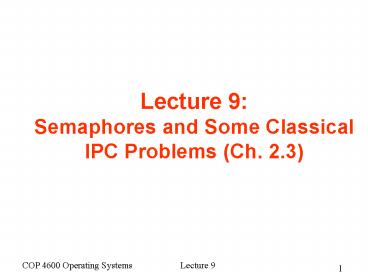Lecture 9: Semaphores and Some Classical IPC Problems Ch' 2'3 - PowerPoint PPT Presentation
1 / 10
Title:
Lecture 9: Semaphores and Some Classical IPC Problems Ch' 2'3
Description:
When you create the semaphore, you can initialize its value to ... ( think busy nightclubs/bouncer) Thread i. critical section; 10. COP 4600 Operating Systems ... – PowerPoint PPT presentation
Number of Views:361
Avg rating:3.0/5.0
Title: Lecture 9: Semaphores and Some Classical IPC Problems Ch' 2'3
1
Lecture 9 Semaphores and Some Classical IPC
Problems (Ch. 2.3)
2
Semaphores (cont)
- A semaphore is like an integer, with three
differences - When you create the semaphore, you can initialize
its value to any integer, but after that the only
operations you are allowed to perform are
increment (increase by one) and decrement
(decrease by one). You cannot read the current
value of the semaphore. - 2. When a thread decrements the semaphore, if the
result is negative, the thread blocks itself and
cannot continue until another thread increments
the semaphore. - 3. When a thread increments the semaphore, if
there are other threads waiting, one of the
waiting threads gets unblocked.
3
Consequences
- In general, there is no way to know before a
thread decrements a semaphore whether it will
block or not. - After a thread increments a semaphore and another
thread gets woken up, both threads continue
running concurrently. There is no way to know
which thread, if either, will continue
immediately. - When you signal a semaphore, you dont
necessarily know whether another thread is
waiting, so the number of unblocked threads may
be zero or one.
4
Syntax (in pseudo-language)
- sem semaphore (value)
- Multiple equivalent notations
- sem.signal() sem.wait()
- sem.up() sem.down()
- sem.V() sem.P()
5
Basic Synchronization Patterns
- Serialization
- Rendez-vous
- Mutual exclusion
- Multiplex
- Barrier (for some of you to figure out)
6
Serialization
- Thread A
- statement a1
- Thread B
- statement b1
Requirement statement a1 runs before statement
b1.
7
Rendez-vous
Thread A statement a1 statement a2
Thread B statement b1 statement b2
- Requirement Thread A has to wait for Thread B
and vice-versa a1 happens before b2 and b1
happens before a2.
8
Mutual Exclusion
Thread A count count 1
Thread B count count 1
- Requirement only one thread accesses the shared
variable at a time. - Question what would be the problem is mutual
exclusion not enforced in this case?
9
Multiplex
Thread i critical section
- Requirement allow multiple threads to run in the
critical section at the same time, but not more
than n threads. (think busy nightclubs/bouncer)
10
Producer/Consumer with Semaphores































